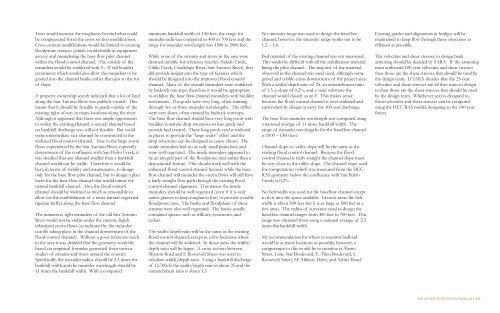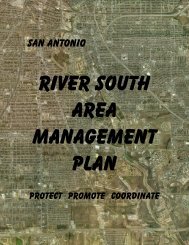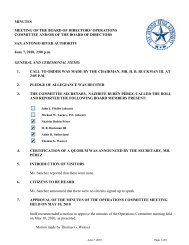concept design san antonio river improvements project
concept design san antonio river improvements project
concept design san antonio river improvements project
Create successful ePaper yourself
Turn your PDF publications into a flip-book with our unique Google optimized e-Paper software.
Trees would increase the roughness beyond what could<br />
be compensated for in the cross section modifications.<br />
Cross section modifications would be limited to creating<br />
floodprone terraces (which could double as equipment<br />
access) and meandering the base flow pilot channel<br />
within the flood control channel. The outside of the<br />
meanders would be stabilized with 5 – 6’ tall boulder<br />
revetments which would also allow the meanders to be<br />
graded into the channel banks rather than just to the toe<br />
of slope.<br />
A property ownership search indicated that a lot of land<br />
along the San Antonio River was publicly owned. This<br />
meant that it should be feasible to grade outside of the<br />
existing right-of-way in many locations along the <strong>river</strong>.<br />
Although it appeared that there was ample opportunity<br />
to widen the existing channel, a natural channel based<br />
on bankfull discharge was still not feasible. But could<br />
some intermediate size channel be constructed in the<br />
widened flood control channel. Due to the large storm<br />
flows experienced by the San Antonio River, especially<br />
downstream of the confluence with San Pedro Creek, it<br />
was decided that any channel smaller than a bankfull<br />
channel would not be stable. Therefore it would be<br />
best, in terms of stability and maintenance, to <strong>design</strong><br />
only for the base flow pilot channel, but to <strong>design</strong> a plan<br />
form for the base flow channel that would mimic the<br />
natural bankfull channel. Also, the flood control<br />
channel should be widened as much as reasonable to<br />
allow for the establishment of a more natural vegetated<br />
riparian buffer along the base flow channel.<br />
The numerous, tight meanders of the old San Antonio<br />
River would not be stable under the current, highly<br />
urbanized storm flows (as indicated by the meander<br />
cutoffs taking place in the channel downstream of the<br />
flood control channel). Without a good reference reach<br />
in the area it was decided that the geometry would be<br />
based on empirical formulas generated from various<br />
studies of streams and <strong>river</strong>s around the country.<br />
Specifically, the meander radius should be 2.3 times the<br />
bankfull width and the meander wavelength should be<br />
11 times the bankfull width. With a computed<br />
minimum bankfull width of 150 feet, the range for<br />
meander radii was computed as 400 to 700 feet and the<br />
range for meander wavelength was 1500 to 2000 feet.<br />
While none of the streams and <strong>river</strong>s in the area were<br />
deemed suitable for reference reaches (Salado Creek,<br />
Cibilo Creek, Guadalupe River, San Antonio River), they<br />
did provide insight into the type of features which<br />
should be <strong>design</strong>ed into the improved flood control<br />
channel. Many of the outside meanders were stabilized<br />
by bedrock outcrops, therefore it would be appropriate<br />
to stabilize the base flow channel meanders with boulder<br />
revetments. The pools were very long, often running<br />
through two or three meander wavelengths. The riffles<br />
were very short, often created by bedrock outcrops.<br />
The base flow channel should have very long pools with<br />
boulder/concrete drop structures to lose grade and<br />
provide bed control. These long pools can be widened<br />
in places to provide the “large water” effect and the<br />
drop structures can be <strong>design</strong>ed as canoe chutes. The<br />
inside meanders had no or only small point bars and<br />
were well vegetated. The inside meanders appeared to<br />
be an integral part of the floodprone area rather than a<br />
depositional feature. This should work well with the<br />
enhanced flood control channel because while the base<br />
flow channel will meander the storm flows will still have<br />
a fairly straight flow path through the existing flood<br />
control channel alignment. This means the inside<br />
meanders should be well vegetated (even if it is only<br />
native grasses to keep roughness low) to provide a stable<br />
floodprone area. The banks and floodplains of these<br />
streams were also well vegetated. The banks usually<br />
contained species such as willows, sycamores, and<br />
cedars.<br />
The width/depth ratio will be the same as the existing<br />
flood control channel, except in a few locations where<br />
the channel will be widened. In those areas the width/<br />
depth ratio will be larger. A cross section between<br />
Mission Road and S. Roosevelt Street was used to<br />
calculate width/depth ratio. Using a bankfull discharge<br />
of 12,700cfs the width/depth ratio is about 25 and the<br />
entrenchment ratio is about 1.3.<br />
No sinuosity range was used to <strong>design</strong> the baseflow<br />
channel; however, the sinuosity range works out to be<br />
1.2 – 1.4.<br />
Bed material of the existing channel was not measured.<br />
This would be difficult with all the stabilization material<br />
lining the pilot channel. The majority of the material<br />
observed in the channel was <strong>san</strong>d sized, although some<br />
gravel and cobble exists downstream of the <strong>project</strong> area.<br />
With a width/depth ratio of 25, an entrenchment ratio<br />
of 1.3, a slope of 0.2%, and a <strong>san</strong>d substrate the<br />
channel would classify as an F. This makes sense<br />
because the flood control channel is over-widened and<br />
entrenched by <strong>design</strong> to carry the 100-year discharge.<br />
The base flow meander wavelength was computed using<br />
a national average of 11 times bankfull width. The<br />
range of meander wavelengths for the baseflow channel<br />
is 1000 – 1500 feet.<br />
Channel slope vs. valley slope will be the same as the<br />
existing flood control channel. Because the flood<br />
control channel is fairly straight the channel slope must<br />
be very close to the valley slope. The channel slope used<br />
for computations (which was measured from the HEC-<br />
RAS geometry below the confluence with San Pedro<br />
Creek) is 0.2%.<br />
No belt width was used for the baseflow channel except<br />
to fit it into the space available. In most areas the belt<br />
width is about 300 feet but it is as large as 500 feet in a<br />
few areas. The radius of curvature used to <strong>design</strong> the<br />
baseflow channel ranges from 400 feet to 700 feet. This<br />
range was obtained from using a national average of 2.3<br />
times the bankfull width.<br />
My recommendation for where to monitor bedload<br />
would be as many locations as possible; however, a<br />
compromise to this would be to monitor at Alamo<br />
Street, Lone Star Boulevard, E. Theo Boulevard, S.<br />
Roosevelt Street, SE Military Drive, and Ashley Road.<br />
Existing grades and alignments at bridges will be<br />
maintained to keep flow through these structures as<br />
efficient as possible.<br />
The velocities and shear stresses to <strong>design</strong> bank<br />
armoring should be decided by SARA. If the armoring<br />
must withstand 100-year velocities and shear stresses<br />
then those are the shear stresses that should be used by<br />
the <strong>design</strong> team. If SARA decides that the 25-year<br />
velocities and shear stresses are all they want to <strong>design</strong><br />
to then those are the shear stresses that should be used<br />
by the <strong>design</strong> team. Whichever year is <strong>design</strong>ed to,<br />
those velocities and shear stresses can be computed<br />
using the HEC-RAS model, <strong>design</strong>ing to the 100-year<br />
forces.<br />
SAN ANTONIO RIVER DESIGN GUIDELINES 127






